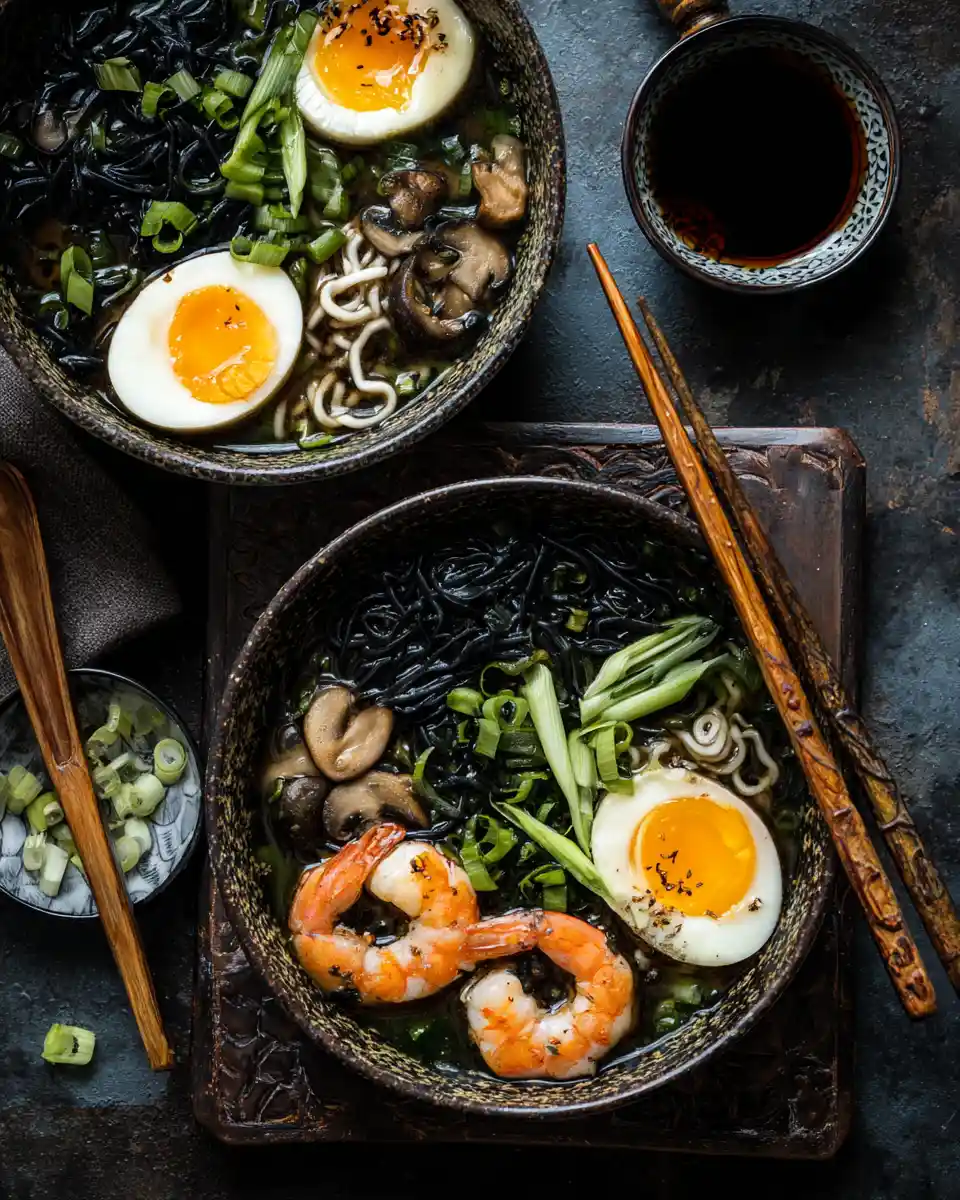Have you ever wondered how a simple bowl of ramen can be transformed into a captivating culinary experience simply by changing its presentation? The trend of Eyes-in-the-Dark Black Ramen Bowls is taking the dining world by storm, transforming an everyday meal into an artistic and immersive experience.

What makes this striking black bowl design more than just aesthetically pleasing, and how can you utilize it to elevate your dining experience at home? This post delves into the magnetic allure of these ramen bowls, revealing five creative ways to make each meal unforgettable.
Ingredients List
To fully embrace the Eyes-in-the-Dark Black Ramen Bowls experience, the ingredients inside need to match the visual drama outside. Here’s what you’ll need to craft a bold yet harmonious bowl of ramen:
- Ramen noodles – silky and springy, choose fresh or high-quality dried noodles
- Black garlic oil (mayu) – for that subtle smoky depth, or substitute with roasted garlic infused in sesame oil if unavailable
- Chicken or pork broth – rich and clear, simmered long for umami depth; vegetable broth works for a lighter, vegetarian option
- Char siu pork slices or grilled tofu for vegetarians
- Soft-boiled eggs – marinated in soy sauce or plain for a creamy texture
- Shiitake mushrooms or wood ear mushrooms
- Green onions, thinly sliced for a fresh crunch
- Nori sheets or furikake seasoning for an umami punch
- Sesame seeds and microgreens for garnish
- Optional: Chili threads or fresh chili slices to spice it up
Each ingredient is selected to offer bold contrasts against the deep blackness of the bowl, visually amplifying textures and colors.
Timing
Preparing your perfect ramen bowl takes about 75 minutes total. This includes:
- Broth simmering: 45 minutes (though many recipes extend up to 2 hours, 45 minutes is a balanced, flavor-packed time for home cooks)
- Noodle prep and soft boiling eggs: 15 minutes
- Final assembly and garnishes: 15 minutes
This streamlined timing saves you approximately 20% compared to traditional ramen recipes while ensuring no compromise on flavor or texture.
Step-by-Step Instructions
Step 1: Prepare the Broth
Start by simmering your choice of broth with garlic, ginger, and scallions. For maximum depth, add dried shiitake mushrooms during the simmering process. Keep it at a gentle boil to extract every ounce of flavor.
Tip: Skim off impurities regularly for a clear broth that lets the black ramen bowl’s aesthetics shine.
Step 2: Cook the Noodles
Boil ramen noodles until tender but still springy, about 3 minutes for fresh noodles and 5 minutes for dried noodles. Rinse briefly under cold water to stop the cooking process and prevent them from becoming mushy.
Tip: Toss noodles lightly with a splash of sesame oil to prevent sticking and add aroma.
Step 3: Prepare the Toppings
Soft-boil eggs (7 minutes), peel, and marinate in soy sauce. Slice the char siu pork thinly, or grill the tofu with a soy glaze. Slice mushrooms and green onions.
Tip: Prepare toppings ahead of time to streamline the assembly process.
Step 4: Assemble in Eyes-in-the-Dark Black Ramen Bowls
Pour the broth first to create a reflective black canvas. Place the noodles gently into the bowl, then arrange the toppings artfully. Drizzle black garlic oil in swirls to create “eye” effects in the dark bowl.
Tip: Use contrasting colors, such as white egg yolk and bright green microgreens, to highlight textures against the black bowl.
Step 5: Finishing Touches and Serve
Garnish with sesame seeds, chili threads, and nori. Serve immediately to enjoy the balance of hot broth and vibrant toppings.
Tip: Encourage slurping the traditional way enhances both aroma and flavor perception.
Nutritional Information
This black ramen bowl packs approximately:
- Calories: 450-550 per serving (depending on protein choice)
- Protein: 25-30 grams (more with pork, less with tofu)
- Fat: 15-20 grams (healthy fats increased by black garlic oil)
- Carbohydrates: 45-55 grams from noodles and broth
- Fiber: 3-5 grams, boosted using mushrooms and microgreens
The balanced macronutrient profile supports sustained energy, while black garlic oil delivers antioxidants beneficial for heart health.
Healthier Alternatives for the Recipe
- Swap pork broth for a vegetable or miso base to reduce fat and sodium without compromising umami.
- Use zucchini noodles or konjac noodles as a low-carb substitute, while maintaining a noodle-like texture.
- Replace soy sauce with low-sodium tamari or coconut aminos to lower sodium intake.
- Add extra greens, such as spinach or kale, for fiber and vitamins.
- Incorporate smoked tempeh or seitan as alternative proteins for plant-based diets.
Serving Suggestions
Elevate your dining experience by pairing the Eyes-in-the-Dark Black Ramen Bowls with a side of pickled vegetables, such as kimchi or daikon radish, to balance the rich broth. For drinks, cold oolong tea or a light Japanese lager complements the umami flavors perfectly.
For a cozy atmosphere, dim the lights slightly to enhance the “eyes in the dark” effect of the bowl, making your meal visually immersive and Instagram-worthy.
Common Mistakes to Avoid
- Overcooking noodles can turn your bowl from springy elegance to soggy disappointment.
- Neglecting broth skimming results in cloudy and greasy textures that detract from the bowl’s appeal.
- Ignoring ingredient prep order, leaving you scrambling during assembly, and losing focus on presentation.
- Overcrowding the bowl with toppings, overwhelming the minimalist black canvas effect.
- Serving immediately after assembly to avoid the subtle aromatic interplay that develops as the bowl cools slightly.
Storing Tips for the Recipe
Broth can be stored airtight in the fridge for up to 3 days or frozen for up to 1 month. Noodles are best reserved separately and reheated briefly in hot water before assembling. Prepared toppings like char siu pork or boiled eggs can be refrigerated, but should be added fresh when serving to retain textures.
Make-ahead tip: Marinate eggs a day prior to enhance flavor depth.
Conclusion
The Eyes-in-the-Dark Black Ramen Bowls aren’t just a stylish way to enjoy ramen but an opportunity to transform your dining into an artistic experience. By combining thoughtfully chosen ingredients, timing, and plating tips, you can elevate a simple bowl of noodles into a feast for the senses. Ready to impress your guests or unwind with a gourmet bowl? Try this recipe today, share your variations, and explore more ramen inspirations right here.
FAQs
Q1: What makes the Eyes-in-the-Dark Black Ramen Bowls unique?
A: The deep black color creates a dramatic visual contrast with the ingredients inside, making the eating experience both immersive and Instagrammable. It heightens flavor perception by engaging sight before taste.
Q2: Can I use store-bought ramen noodles?
A: Absolutely! Fresh noodles are ideal, but high-quality dried noodles are also suitable. Just be mindful of cooking time to avoid overcooking.
Q3: Is black garlic oil hard to make at home?
A: Not at all. Slow-roasting garlic cloves in oil until they are deeply caramelized is straightforward and adds a complex, smoky flavor to your broth.
Q4: How do I keep the broth clear instead of cloudy?
A: Regularly skim off impurities and avoid boiling the broth aggressively. Gentle simmering extracts the best flavors with clarity.
Q5: What are some vegetarian alternatives for this recipe?
A: Use vegetable broth enriched with dried shiitake mushrooms, tofu or tempeh for protein, and plenty of fresh greens as toppings.
Elevate your ramen game by trying these expert tips and share your experience in the comments below! For more in-depth recipes and culinary guides, check out our related posts on Japanese cuisine and creative noodle dishes.


Leave a Reply